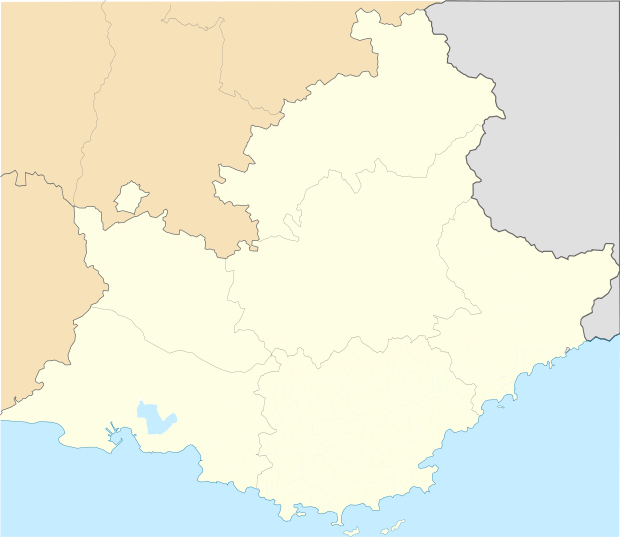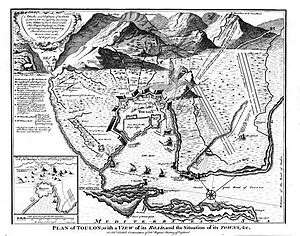Siege of Toulon (1707)
The Siege of Toulon took place between 29 July to 21 August 1707 during the War of the Spanish Succession when an Allied land and sea force besieged the French naval base at Toulon. The siege failed, but the French sank their ships to prevent them being captured. Most of the ships were later refloated, but this cemented Allied naval control of the Western Mediterranean.
Background

After the failure of the Siege of Turin on 7 September, French forces in Piedmont withdrew across the Alps into the Savoyard territories of Villefranche and County of Savoy. Despite victory at Castiglione two days later, their garrisons in Lombardy were isolated and could not be reinforced. The March 1707 Convention of Milan between France and Austria surrendered Milan and other French-occupied towns in Lombardy to the Imperial army, with the garrisons given free passage back to France for use elsewhere.
Sir Richard Hill, English ambassador to Savoy 1703–1706, had been trying to persuade Victor Amadeus to support an attack on the French base at Toulon for some time.[1] This now resurfaced; capturing Toulon would cement Allied naval supremacy, support the Protestant Camisard revolt in Southern France, divert Bourbon forces from Spain and win back Villefranche and the County of Savoy.
By April 1707, the Allies had assembled an army of 35,000 but the campaign was delayed until July when the Austrians detached 10,000 troops to capture Naples.[2] The consolidation of Habsburg power in Italy made Victor Amadeus cautious; French garrisons still held parts of north-west Piedmont while many of the commitments made by Austria in the 1703 Treaty of Turin had not been fulfilled.[lower-alpha 1][3]
The siege
Supported by a British squadron under Admiral Cloudesley Shovell, Prince Eugene and Victor Amadeus crossed the Alps via the Col de Tende on 6 July. They reoccupied Nice and marched along the coast from Antibes to Cuers reaching La Valette du Var outside Toulon on 29 July.[4]
.jpg)
The Bourbon victory of Almansa in April allowed them to reinforce Marshal René de Froulay de Tessé who had over 20,000 men based outside Toulon. The city itself was strongly defended with plenty of artillery, supported by the guns of French warships in the harbour.[5] Before commencing siege operations, the Allies had to clear the heights of French troops which was completed by 6 August. They then learned that the Count of Médavy was assembling an army at Riez, threatening to cut off their retreat.[lower-alpha 2] The Allies were outnumbered, an anticipated uprising by Protestant Camisard rebels had not occurred while adverse weather limited the support provided by the navy.
On 14 August, Tessé retook the vital heights of Santa Catarina; the Allies had captured the important outworks of Fort St Margaret on 10 August, followed by Fort St Louis on 18th but their situation was precarious. They decided to withdraw and began their retreat on 22 August; as they did so, Shovell's ships bombarded the harbour, sinking two French warships and setting fire to the naval stores in the lower town.[6]
Aftermath
Over 46 French warships of between 50 and 110 guns were based in Toulon harbour, and when the two forts fell on 19 August, they were sunk to prevent capture or being destroyed by attackers' fire, and to block entry into the port.[7] Many were damaged beyond repair or not raised until after the war ended, giving the Allies control of the Western Mediterranean. Prince Eugene and Victor Amadeus recrossed the Alps in early September and expelled the remaining French garrisons in Northwest Piedmont but Villefranche and the County of Savoy remained in French hands until 1714.[8] Vauban, in his Oisivetés, attributes this partial scuttling to optimism of local authorities which expected to recover the ships after the end of the siege. However, the recovered unrigged ships did not play any major role in the pursuit of the war, leaving effective control of the Western Mediterranean to the British.
The failure cost the Allies around 13,000 men, from casualties, disease and desertion; many contemporaries blamed Victor Amadeus, suggesting he was either bribed by the French or had no interest in taking Toulon.[9] This view is still reflected in modern accounts but in retrospect, even without the delays it was overly ambitious; the 1793 Siege showed capturing Toulon was one thing, holding it another.
On their return voyage to England in October 1707, navigational errors caused the loss of four ships and 2,000 men including Shovell in the Scilly naval disaster of 1707, which led to the 1714 Longitude Act.[lower-alpha 3]
Footnotes
- The main issue being Milan, a Spanish possession Archduke Charles had agreed to cede to Austria but kept secret since it would certainly be resisted by his Spanish supporters.
- Much of this consisted of French troops evacuated from Lombardy by the Convention of Milan.
- This offered cash prizes for devising a method of accurately calculating longitude.
References
- Blackley, William (1845). The Diplomatic Correspondence of the Right Hon. Richard Hill ...: Envoy Extraordinary from the Court of St. James to the Duke of Savoy ... from July 1703, to May 1706 (2010 ed.). Nabu Press. p. 707 passim. ISBN 1145943462.
- Symcox, Geoffrey (1983). Victor Amadeus II: Absolutism in the Savoyard State, 1675-1730. University of California Press. p. 154. ISBN 0520049748.
- Frey, Linda, Frey, Marsha (1995). The Treaties of the War of the Spanish Succession: An Historical and Critical Dictionary. Greenwood. p. 471. ISBN 0313278849.
- Bancks, John (1745). The history of Francis-Eugene Prince of Savoy (2010 ed.). Gale ECCO. pp. 245–249. ISBN 1170621236.
- "Toulon fortifications in 1707". Oderint dum Probent; Military Blog. Retrieved 1 May 2018.
- Bancks, John (1745). The history of Francis-Eugene Prince of Savoy (2010 ed.). Gale ECCO. pp. 254–256. ISBN 1170621236.
- Holmes, Richard (2008). Marlborough; England's Fragile Genius. Harper Press. p. 359. ISBN 0007225725.
- Bancks, John (1745). The history of Francis-Eugene Prince of Savoy (2010 ed.). Gale ECCO. pp. 258–259. ISBN 1170621236.
- Bancks, John (1745). The history of Francis-Eugene Prince of Savoy (2010 ed.). Gale ECCO. pp. 259–260. ISBN 1170621236.
Sources
- Bancks, John; The history of Francis-Eugene Prince of Savoy; (1745);
- Holmes, Richard. Marlborough: Britain's Greatest General: England's Fragile Genius, Harper Perennial,
- Symcox, Geoffrey; Victor Amadeus II: Absolutism in the Savoyard State, 1675-1730. (University of California Press, 1983)
